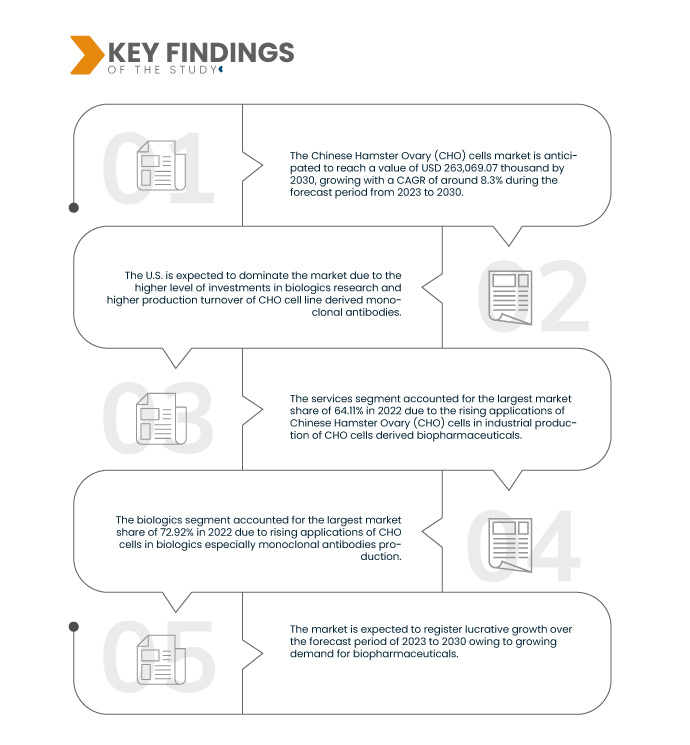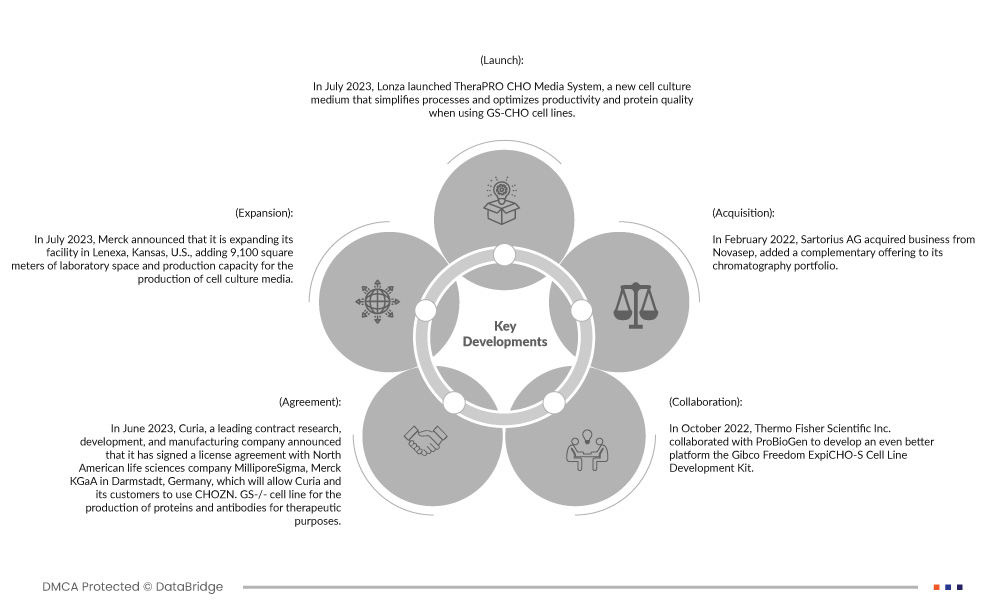The increasing use of CHO cells in genetic studies reflects their unique advantages in the field of genetic research. CHO cells are renowned for their genetic stability. Researchers study specific genes or genetic modifications without the concern of unexpected genetic changes interfering with their experiments. This stability is particularly crucial when conducting precise gene editing or investigating the long-term effects of genetic modifications.
CHO cell's proficiency in expressing recombinant proteins is another compelling reason for their increasing use in genetic research. Researchers can introduce specific genes encoding proteins of interest into CHO cells. These cells then act as mini-bioreactors producing and secreting the desired proteins. This capability is essential for studying the functions of specific genes, investigating the effects of genetic mutations, and producing therapeutic-proteins for both research and biopharmaceutical applications.
Access Full Report @ https://www.databridgemarketresearch.com/reports/north-america-chinese-hamster-ovary-cells-cho-market
Data Bridge Market Research analyzes that the North America Chinese Hamster Ovary (CHO) Cells Market is expected to grow with a CAGR of 8.3% in the forecast period of 2023 to 2030 and is expected to reach USD 263,069.07 thousand by 2030 from USD 143,106.10 thousand in 2022.
Key Findings of the Study
Growing Demand for Biopharmaceuticals
Biopharmaceuticals, also known as biologics, have demonstrated remarkable therapeutic outcomes in areas such as oncology, autoimmune diseases, and rare genetic disorders. For instance, monoclonal antibodies, a common type of biopharmaceutical, have transformed cancer treatment by targeting cancer cells directly while sparing healthy ones. biopharmaceuticals also offer promising approaches to managing previously untreatable conditions and rare diseases, which were often neglected by traditional drug development due to their limited patient populations.
The growing demand for biopharmaceuticals has a positive impact on the market, as CHO cells are a primary tool for the production of biopharmaceuticals. There is a corresponding rise in the requirement for CHO cells to produce these complex biological drugs as the biopharmaceutical industry expands to meet the increasing need for innovative and effective treatments.
Report Scope and Market Segmentation
|
Report Metric
|
Details
|
|
Forecast Period
|
2023 to 2030
|
|
Base Year
|
2022
|
|
Historic Years
|
2021 (Customizable to 2015-2020)
|
|
Quantitative Units
|
Revenue in USD Thousand, ASP in USD, and Volume in Units
|
|
Segments Covered
|
Type (Services and Product), System (Metabolic Selection System, Antibiotic Selection System and Others), Application (Biologics and Medical Research), End User (Biopharmaceutical Companies, Biotechnology Companies, Clinical Development and Manufacturing Organizations, Clinical Research Organizations, Academic Institutes and Research Organizations, and Others), Distribution Channel (Direct Tenders, Retail Sales, and Others)
|
|
Countries Covered
|
U.S., Canada, and Mexico
|
|
Market Players Covered
|
Thermo Fisher Scientific Inc. (U.S.), AcceGen (U.S.), RayBiotech Life, Inc. (U.S.), CLS Cell Lines Service GmbH (Germany), BPS Bioscience, Inc. (U.S.), GenTarget Inc. (U.S.), Merck KGaA (Germany), Promega Corporation (U.S.), Abeomics (U.S.), Applied Biological Materials Inc. (abm) (Canada), ATCC (U.S.), Sartorius AG (Germany), Lonza (Switzerland), Horizon Discovery Ltd. (U.K.), Cytiva (U.S.) and Curia Global, Inc. (U.S.), among others
|
|
Data Points Covered in the Report
|
In addition to the insights on market scenarios such as market value, growth rate, segmentation, geographical coverage, and major players, the market reports curated by the Data Bridge Market Research also include depth expert analysis, patient epidemiology, pipeline analysis, pricing analysis, and regulatory framework.
|
Segment Analysis
The North America Chinese Hamster Ovary (CHO) cells market is segmented into five notable segments based on type, system, application, end user, and distribution channel.
- On the basis of type, the market is segmented into services and product.
In 2023, the services segment is expected to dominate the North America Chinese Hamster Ovary (CHO) cells market
In 2023, the services segment is expected to dominate the market with 64.46% market share owing to the increasing demand for specialized services related to CHO cell line development, bioprocessing, and contract manufacturing.
- On the basis of system, the market is segmented into metabolic selection system, antibiotic selection system, and others.
In 2023, the metabolic selection system segment is expected to dominate the North America Chinese Hamster Ovary (CHO) cells market
In 2023, the metabolic selection system segment is expected to dominate the market with 73.17% market share because of its efficiency in generating high-producing CHO cell lines for biopharmaceutical production.
- On the basis of application, the market is segmented into biologics and medical research. In 2023, the biologics segment is expected to dominate the market with 73.02% market share.
- On the basis of end-user, the market is segmented into biopharmaceutical companies, biotechnology companies, clinical development and manufacturing organizations, clinical research organizations, academic institutes and research organizations, and others. In 2023, the biopharmaceutical companies segment is expected to dominate the market with 43.02% market share.
- On the basis of distribution channel, the market is segmented into direct tenders, retail sales, and others. In 2023, direct tenders is expected to dominate the market with 66.78% market share.
Major Players
Data Bridge Market Research analyzes Lonza (Switzerland), Sartorius AG (Germany), Merck KGaA (Germany), Cytiva (U.S.), and Thermo Fisher Scientific Inc. (U.S.) are the major market players of North America Chinese Hamster Ovary (CHO) cells market.
Market Developments
- In July 2023, Lonza launched TheraPRO CHO Media System, a new cell culture medium that simplifies processes and optimizes productivity and protein quality when using GS-CHO cell lines. The startup supports pharmaceutical and biotech companies producing therapeutic proteins to further improve product quality. The TheraPRO CHO Media System provides efficient performance, achieving high concentrations of viable cells and protein titers above 5 g/L over a 15-day culture period. This represents more than double the protein titer that can be produced with commercially available solutions. This launch has helped the company to expand its product portfolio in the market.
- In July 2023, Merck announced that it is expanding its facility in Lenexa, Kansas, U.S., adding 9,100 square meters of laboratory space and production capacity for the production of cell culture media. This expansion makes Lenexa the company's largest dry powder cell culture facility and a center of excellence in North America. The investment in the region reflects the company's strategy to expand and diversify its supply chain to meet current and future demand for cell culture platforms.
- In June 2023, Curia, a leading contract research, development, and manufacturing company announced that it has signed a license agreement with North American life sciences company MilliporeSigma, Merck KGaA in Darmstadt, Germany, which will allow Curia and its customers to use CHOZN. GS-/- cell line for the production of proteins and antibodies for therapeutic purposes. Following the agreement, the CHOZN GS-/- cell line will be integrated into Curia's cell line development workflow and immediately available to Curia's customers.
- In October 2022, Thermo Fisher Scientific Inc. collaborated with ProBioGen to develop an even better platform the Gibco Freedom ExpiCHO-S Cell Line Development Kit. This kit allows users to generate cell lines suitable for clinical development without their own original cells, vectors, or previous experience in the field. ProBioGen significantly contributed to the performance of the Freedom ExpiCHO-S kit by leveraging its strong expertise in cell line and process development. The new series utilizes Thermo Fisher's ExpiCHO-S cell line expanding the company's product portfolio for the CHO cell line development series.
- In February 2022, Sartorius AG acquired business from Novasep, added a complementary offering to its chromatography portfolio. The acquired portfolio includes chromatography systems primarily suited for small biomolecules such as oligonucleotides, peptides, and insulin, and innovative systems for the continuous production of biopharmaceuticals.
Regional Analysis
Geographically, the regions covered in the market report are U.S., Canada, and Mexico.
As per Data Bridge Market Research analysis:
U.S. is the dominant and fastest growing country in the North America Chinese Hamster Ovary (CHO) cells market
The U.S. is the dominating country the Chinese Hamster Ovary (CHO) cells market owing to the higher level of investments in biopharmaceutical industry. The U.S. will continue to be the fastest growig country in the North America Chinese Hamster Ovary (CHO) cells market due to the growing applications of mammalian cell cultures especially CHO cells in medical and biotechnology research.
For more detailed information about the North America Chinese Hamster Ovary (CHO) cells market report, click here – https://www.databridgemarketresearch.com/reports/north-america-chinese-hamster-ovary-cells-cho-market












